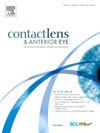DREAM©研究中睑板腺功能障碍的定义对干眼病中MGD发生频率的影响
IF 3.7
3区 医学
Q1 OPHTHALMOLOGY
引用次数: 0
摘要
目的:睑板腺功能障碍(MGD)是一种常见病,目前尚无标准的临床定义。本研究探讨了干眼病(DED)中不同临床定义的MGD的频率和特征。方法:对DREAM©研究参与者(n = 535)中至重度DED患者的数据进行二次分析。MG常见的三个临床特征;堵塞、分泌质量和MG萎缩等级,单独或联合用于创建MGD定义。根据每只眼睛的检查结果,报告了MGD的发生频率。比较MGD患者和非MGD患者的人口学特征。结果:DED中MGD的发生率从12%(腺体堵塞加分泌质量差加腺体萎缩)到55%(单独腺体堵塞)不等。当使用基于萎缩的定义时,年龄越大与MGD相关(p 0.05)。在调整了年龄和眼间相关性后,基于下眼睑萎缩的定义中,女性的MGD频率更高(调整p)。结论:DED中MGD的频率随MGD定义而变化。最高频率发生在MGD被定义为下眼睑腺堵塞的地方。腺体萎缩随年龄增长而增加。疾病频率的变化对临床诊断和干预研究的疗效评估具有重要意义。本文章由计算机程序翻译,如有差异,请以英文原文为准。
Impact of definition of meibomian gland dysfunction on the frequency of MGD in dry eye disease from the DREAM© study
Purpose
Meibomian gland dysfunction (MGD) is a common disease, yet there is no standard clinical definition. This study explored the frequency and characteristics of MGD in dry eye disease (DED) using different clinical definitions.
Methods
A secondary analysis of data collected from the DREAM© study participants (n = 535) with moderate-to-severe DED was undertaken. Three common MG clinical features; plugging, secretion quality, and MG atrophy grade, either separately or in combination were used to create MGD definitions. The frequency of MGD, defined by the per eye findings, was reported. Demographic characteristics were compared between those with and without MGD.
Results
The frequency of MGD in DED varied from 12 % (gland plugging, plus poor secretion quality plus gland atrophy) to 55 % (gland plugging alone) of eyes. Older age was associated with MGD when atrophy-based definitions were used (p < 0.001) but was not associated with MGD definitions using plugging or secretion quality (p > 0.05). After adjustment for age and between-eye correlations, MGD frequency was higher in women for definitions based on lower lid gland atrophy (adjusted p < 0.05). Hispanic or Latino ethnicity was more commonly associated with MGD than other ethnicities (adjusted p < 0.001), for definitions based on plugging and secretion quality.
Conclusion
The frequency of MGD in DED varied with MGD definition. The highest frequency occurred where MGD was defined as lower eyelid gland plugging. Gland atrophy increased with age. The variation in disease frequency has implications for clinical diagnosis and determining efficacy assessment in intervention studies.
求助全文
通过发布文献求助,成功后即可免费获取论文全文。
去求助
来源期刊

Contact Lens & Anterior Eye
OPHTHALMOLOGY-
CiteScore
7.60
自引率
18.80%
发文量
198
审稿时长
55 days
期刊介绍:
Contact Lens & Anterior Eye is a research-based journal covering all aspects of contact lens theory and practice, including original articles on invention and innovations, as well as the regular features of: Case Reports; Literary Reviews; Editorials; Instrumentation and Techniques and Dates of Professional Meetings.
 求助内容:
求助内容: 应助结果提醒方式:
应助结果提醒方式:


